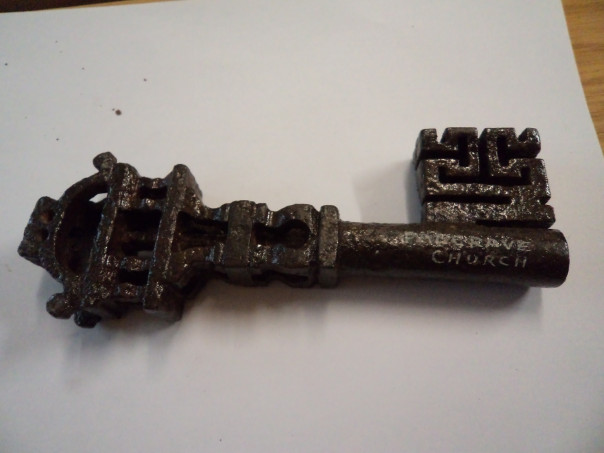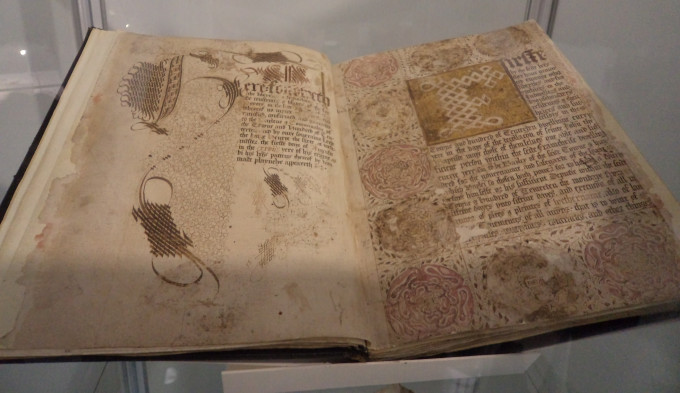As promised last week, I will be giving a short report on Maureen’s presentation to the Kent History Postgraduates today, but because she will be giving a talk to Leigh Local History Society on the same topic soon, I shall keep it brief. Furthermore, Maureen is almost within a month of submitting her thesis where David Willard will be appearing again, which is another reason for only giving an outline here.
Maureen’s research on the development of Tonbridge from medieval times to the end of the 17th century has taken her into topics that originally she wasn’t intending to explore in detail. However, like doctoral research projects firmly based in the archives, she has very sensibly followed where the evidence has taken her. Two areas that feature heavily are the formation, use, break-up and subsequent use of the deer parks and chases, and the relatively short-lived iron industry. One way of exploring the latter has been to assess the career of David Willard and his sons and it was David’s life that was the subject of Maureen’s presentation to her audience in the room as well as online.

As is often the case, tracking an individual in the archives can be both time-consuming and tantalising and Willard is no exception. Nevertheless, Maureen has done an excellent job of finding references to him, for example in pardon rolls and court cases, as a lease holder and as a farmer of tithes. He called himself a yeoman of Leigh and an iron maker of Tonbridge and these two aspects would seem to sum up his commercial dealings for he appears to have been a farmer in the broadest sense of the word in that he made use of what grew on the land he leased, although rather than cereals it was trees he harvested, including to the detriment of the land owner in that he did not replace what he had cut down. Indeed, the owner took legal proceedings against him concerning this felling, as well as the breaking of the fences around the deer parks and the stealing of lead from the roof of Tonbridge castle.
In terms of his time as an iron maker, this probably coincided with the hay day of the industry in the Tonbridge areas, albeit the furnaces he was involved in did not make iron for guns, probably because the ore available was not as good quality as that elsewhere in the Weald. Nonetheless, he appears to have been successful which allowed him to acquire further land and other assets that he was able to pass on to his sons. Thus, by tracing his activities and allowing for the fact that he was in some ways exceptional, as well as by placing him within the context of iron makers locally, regionally and nationally, Maureen offered a fascinating social history of this early modern industry.

As you can imagine, Maureen’s presentation sparked a considerable number of questions and comments, and this became a discussion about other such individuals people are studying in various towns in Kent. One of these areas was the status individuals had used to describe themselves and how the terms yeoman and gentleman can at times be seen ascribed to men seemingly of comparable wealth, yet one or other term was seen as carrying additional meanings which an individual wished to espouse.
In some ways following on from Maureen’s presentation, next month it will be Kieron giving the presentation on the man who may be said to have professionalised naval victualling under the later Tudors which was of special importance at Dover.
Now to another meeting I attended this week because it was the monthly meeting of the Lossenham project wills group. This volunteer community group is working on the probate materials of parishes in the Rother Levels and the adjacent Wealden parishes. Moreover, several members of the Kent History Postgraduates group are project members too. Just to give you a flavour of the meeting, I’m going to mention two discussions. The first relates to a short piece Diane had in the last Lossenham project newsletter where she had used 8 wills to focus on the Tilden family in Tenterden and Benenden. For having published an article in Archaeologia Cantiana (2025) on a later family member who had gone to America aboard the Hercules, she was keen to know more about earlier generations in the 15th and 16th centuries. As a result of this newsletter report, Sue M had been in touch with Diane because she had found references to other family members who too had gone to America, thereby linking up to Diane’s piece. This sparked a general discussion among the group about the best way forward to publicise these findings because they offer an interesting case study about how, when and why such emigration took place, as well as ideas about why some returned to England sometimes after only a very short time.

The second discussion centred around Sue H’s Tenterden Custumal project which is gaining momentum. The idea is to provide facsimiles of the 16th-century custumal and copies of associated documents that are in one of the town’s books. This will become an educational resource for groups within Tenterden and further afield, as well as providing volunteers with the chance to learn about manuscript production and gain experience as transcribers. This, too, is another exciting project and the first task will be to get high quality digital images of the illustrated pages in the manuscript, which is held in the Kent Archives at Maidstone.
Just finally, I thought I would mention that I’ll be giving the next Canterbury Historical Association lecture on Thursday 6 February at 7pm in the Clagett Auditorium, Canterbury Cathedral Lodge. The title is ‘A gateway county: migrants in 15th-century Canterbury and Kent’ and this is the abstract: “currently migration remains high on the political agenda and often provokes strong responses from people with widely differing views. This is not a new phenomenon and while much has been written on the religious and other refugees in the sixteenth and seventeenth centuries, there has been less interest in the previous century. Yet the period witnessed considerable movements of people, as well as goods and ideas, for while trade was a significant factor concerning who, when, where and why people crossed the seas in relation to Canterbury, and Kent more broadly, it was not the only motivating factor and the opportunity to enhance one’s social status, as today, was similarly valued. Consequently, we’ll meet a range of artisans and traders who came to late medieval Canterbury, as well as briefly setting the arrival of such aliens in a regional context.” If this sounds interesting, please do come along.
 Centre for Kent History and Heritage
Centre for Kent History and Heritage Sheila Sweetinburgh
Sheila Sweetinburgh 1834
1834

